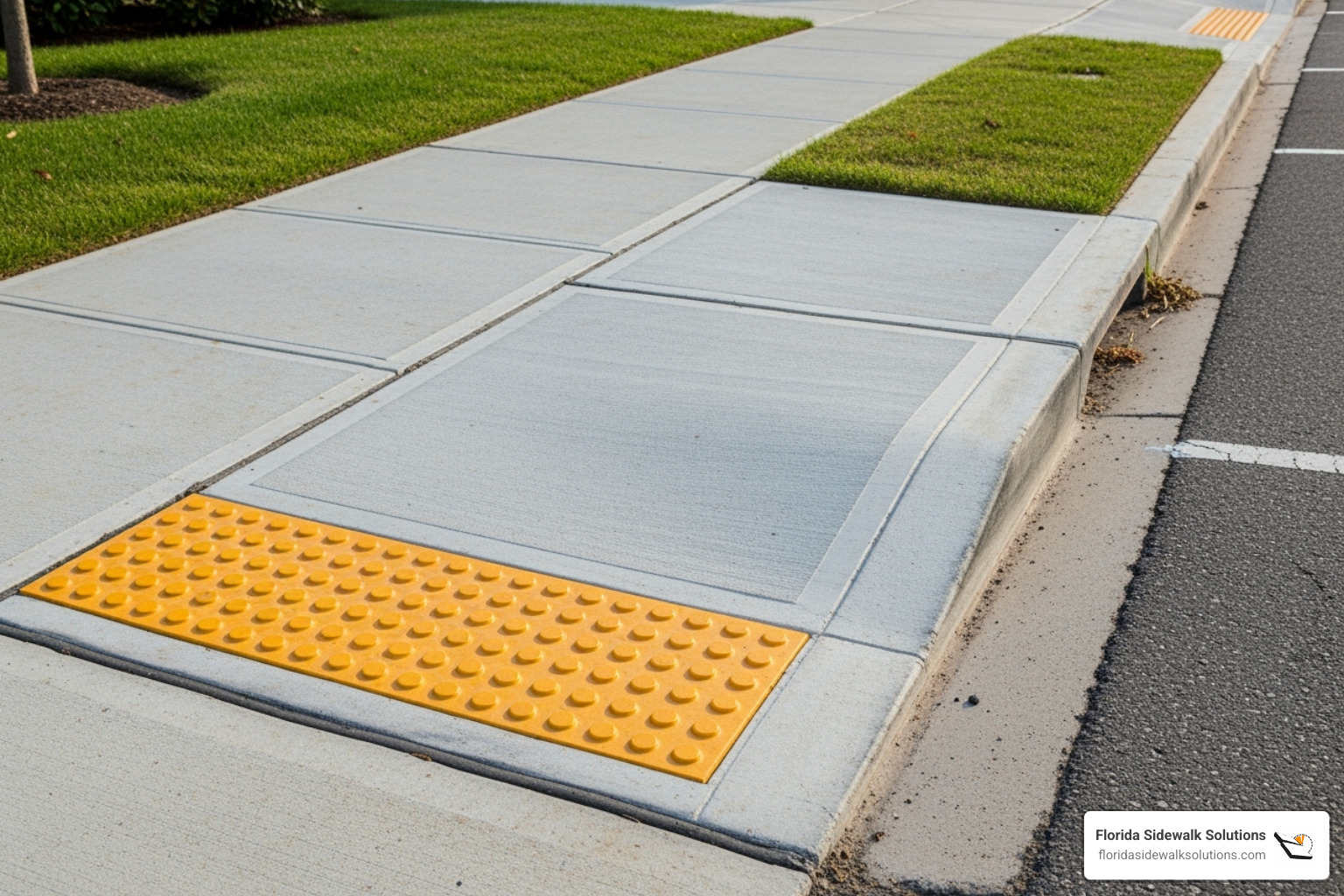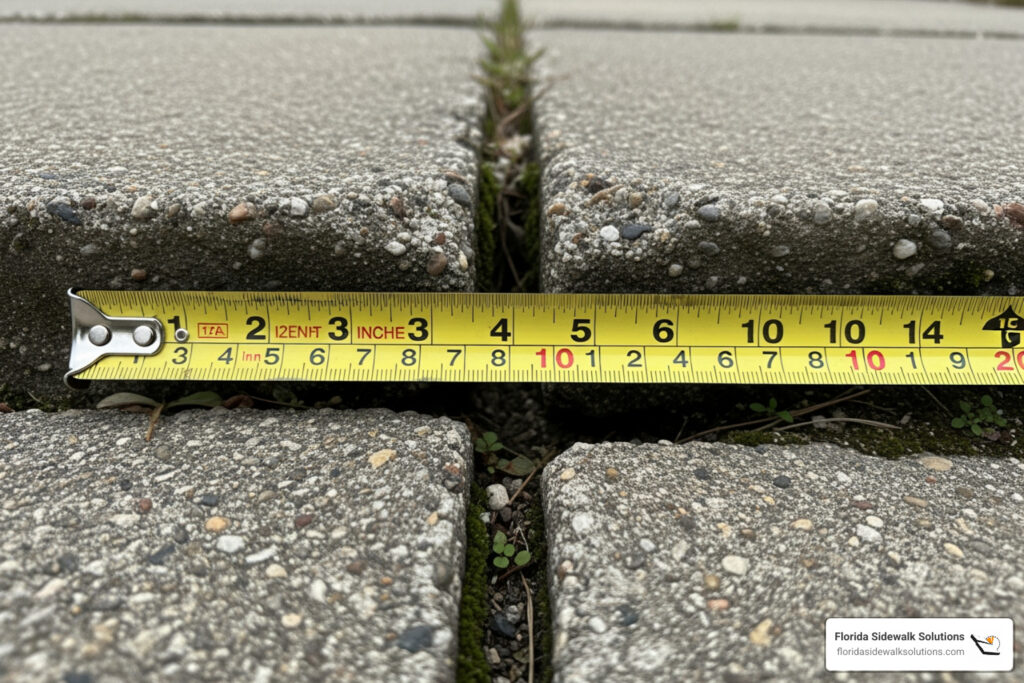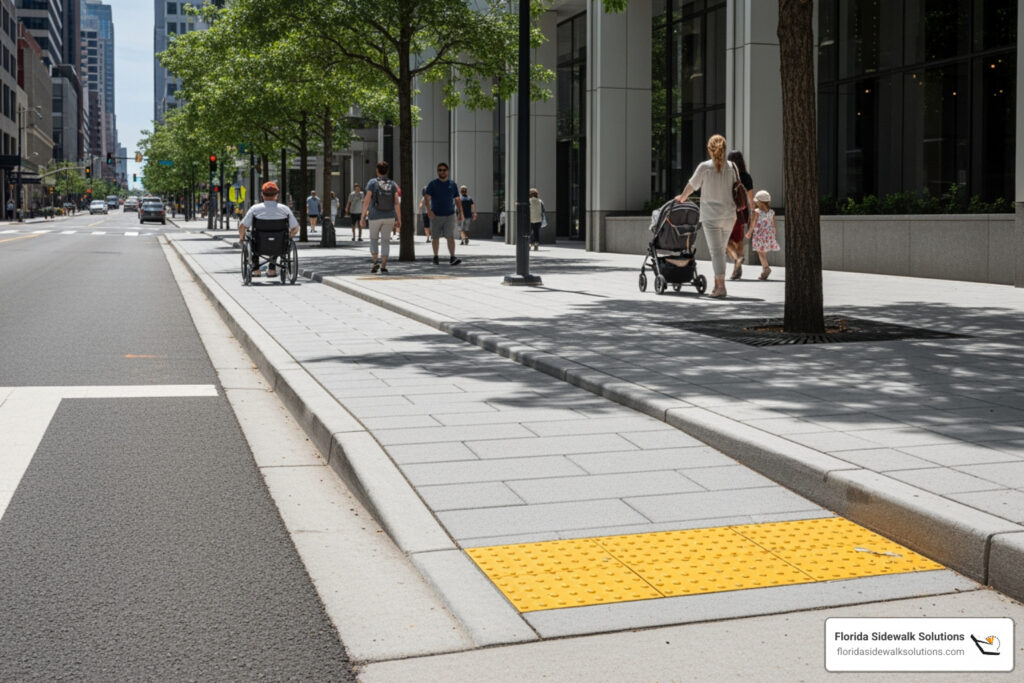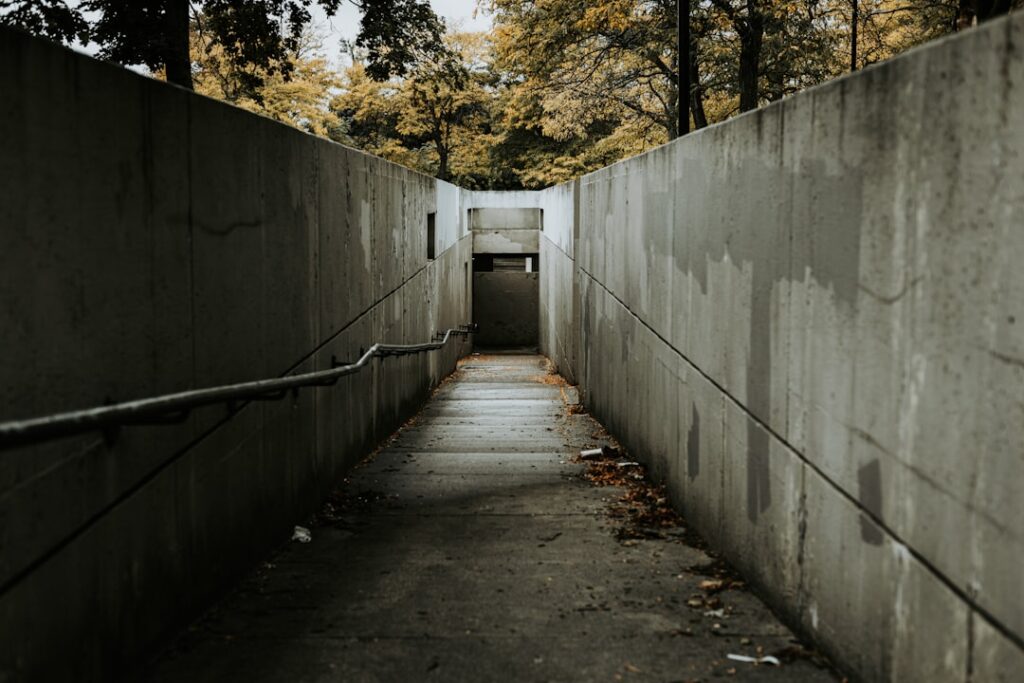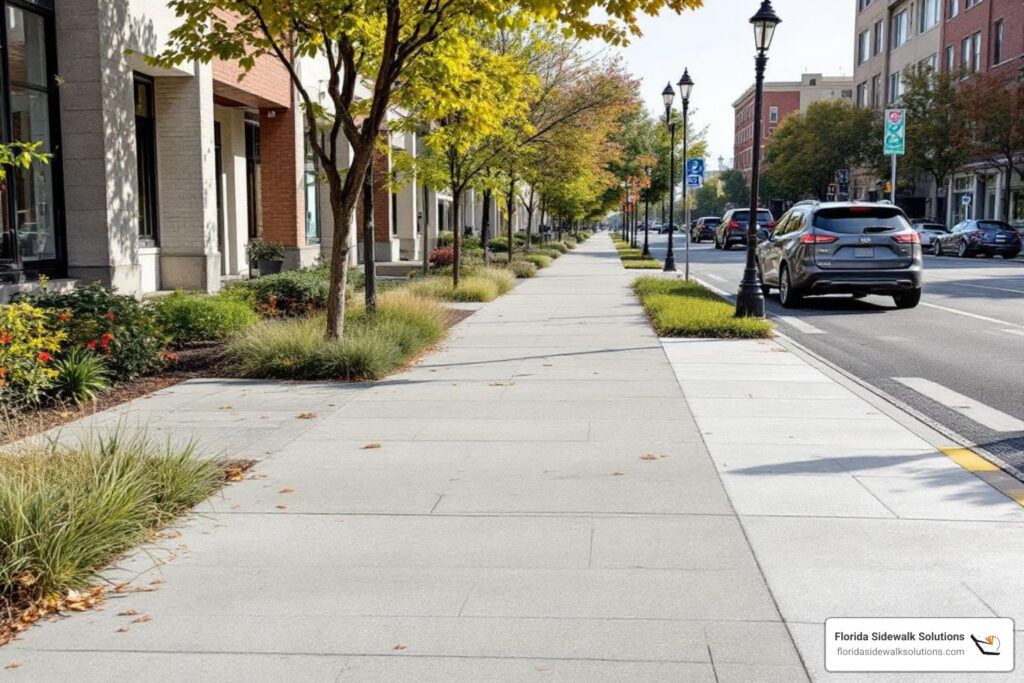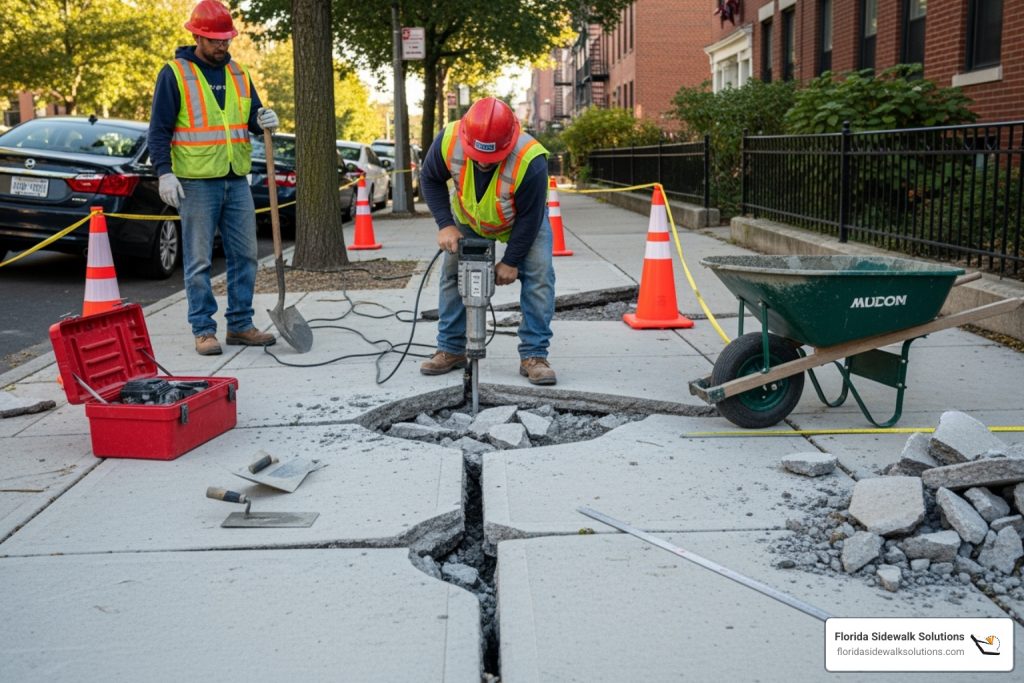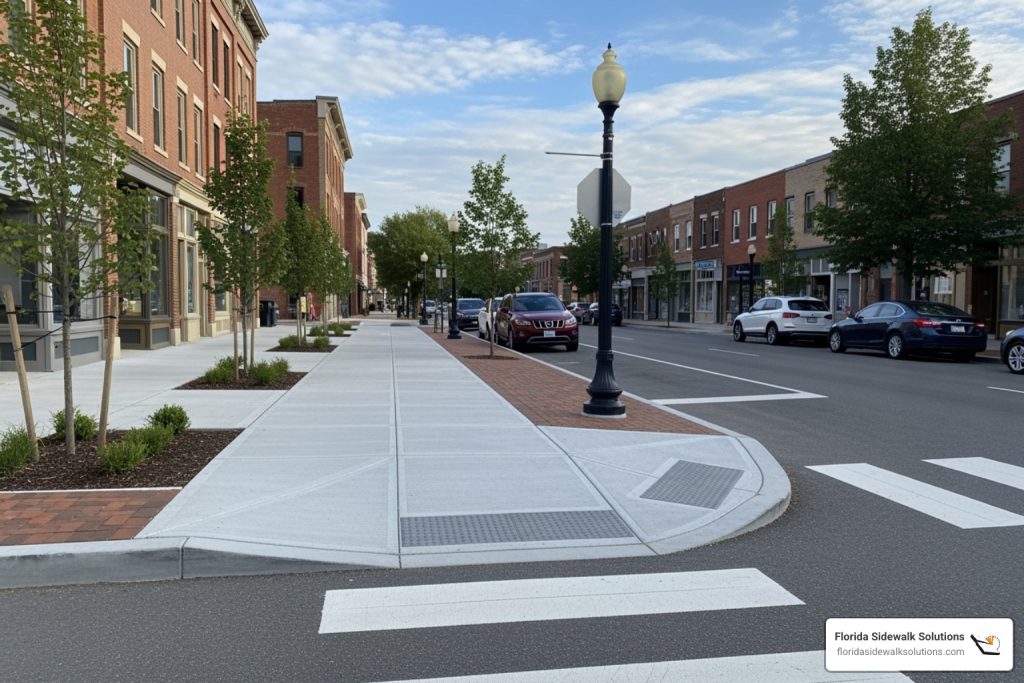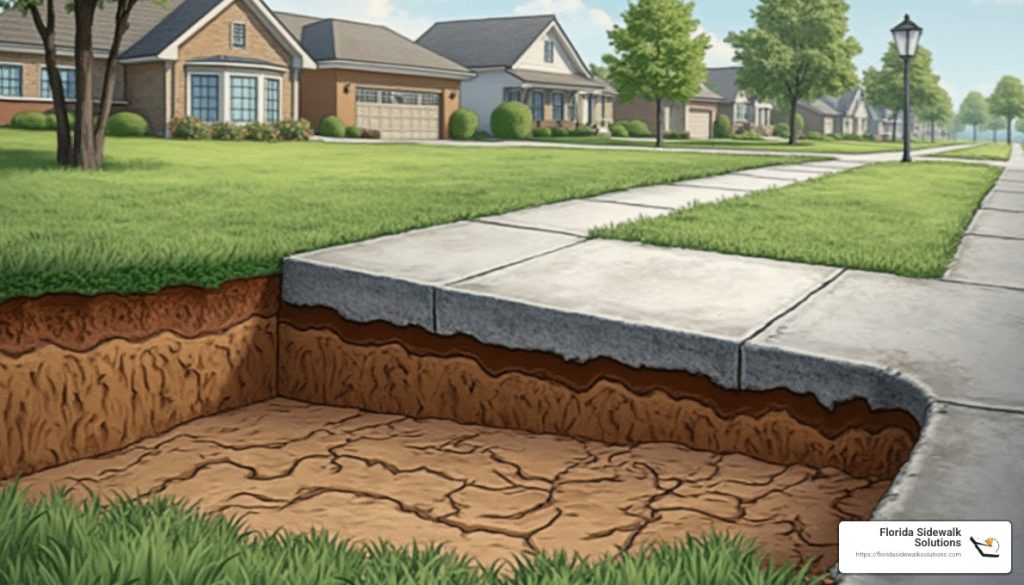Why ADA Compliant Sidewalks Matter for Public Safety
ADA compliant sidewalks must meet specific federal standards established by the Americans with Disabilities Act of 1990 to ensure accessibility for people with disabilities. These requirements are critical for municipal maintenance managers seeking cost-effective solutions for public walkways.
Key ADA Sidewalk Requirements:
- Width: Minimum 36 inches, with 60×60 inch passing spaces every 200 feet.
- Slope: Running slope less than 1:20 (5%); cross slope less than 1:48 (2%).
- Surface: Firm, stable, slip-resistant with gaps no larger than ½ inch.
- Trip Hazards: Vertical changes over ¼ inch must be eliminated or beveled.
- Curb Ramps: Maximum 1:12 slope with detectable warning surfaces.
Non-compliance creates serious risks, including lawsuits and government fines up to $75,000 for first violations and $150,000 for subsequent offenses. More importantly, unsafe sidewalks endanger vulnerable pedestrians.
For managers with budget constraints, trip hazard removal is the most pressing compliance issue. While traditional grinding or replacement is costly and disruptive, modern concrete cutting technology offers an efficient alternative that eliminates liability and preserves existing sidewalks.
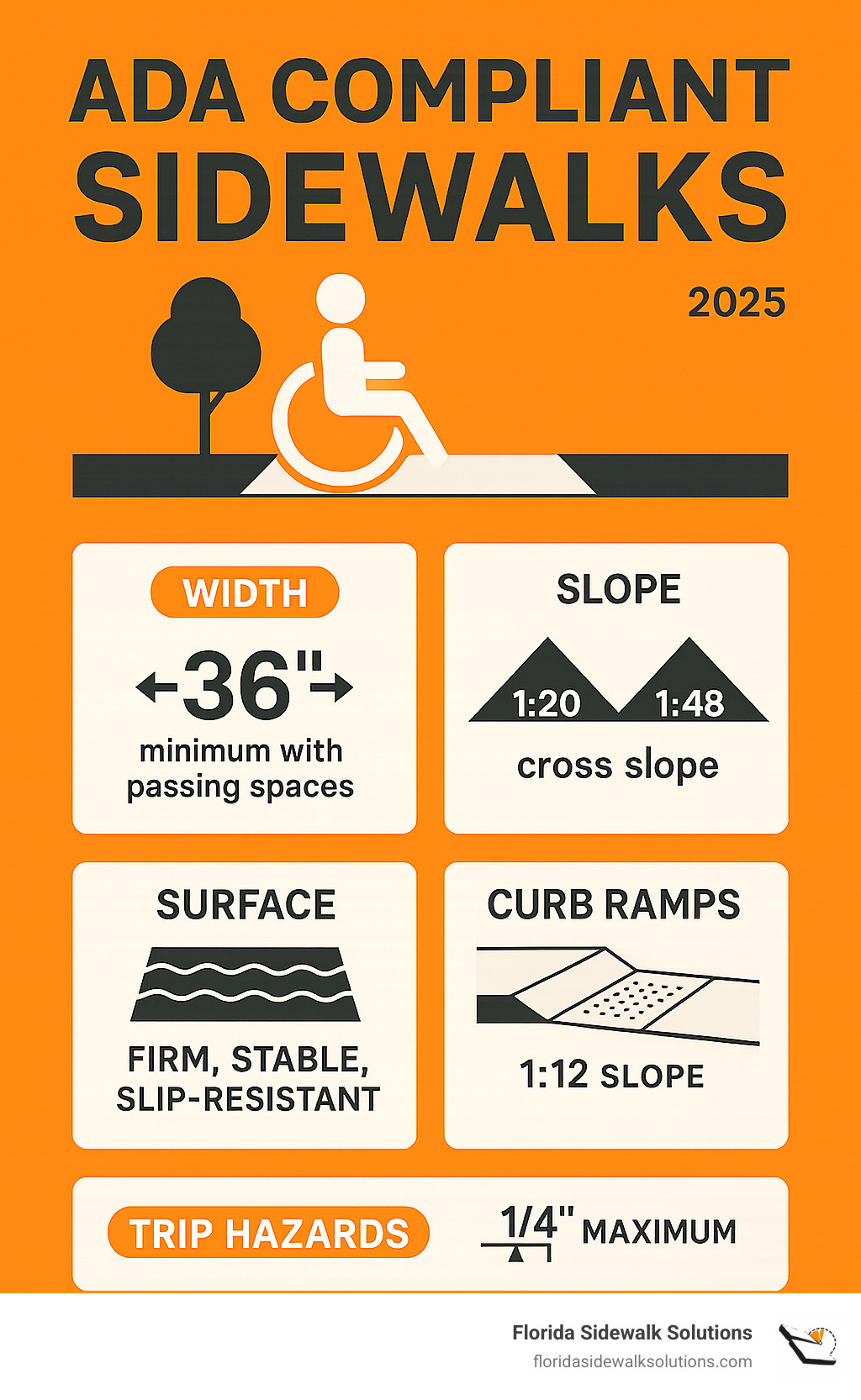
ADA compliant sidewalks terminology:
The “Who” and “Why” of ADA Sidewalk Compliance
Creating accessible sidewalks isn’t just good practice—it’s the law. The Americans with Disabilities Act (ADA) of 1990 mandates that everyone has equal access to public spaces, including ADA compliant sidewalks for people using wheelchairs, walkers, or other mobility devices. Properly designed and maintained sidewalks create safer, more inclusive communities for everyone, from a parent with a stroller to a person using a wheelchair.
Beyond inclusivity, there are serious legal and financial reasons to prioritize ADA compliance. Non-compliance can lead to hefty fines, costly lawsuits, and put community members at risk of injury. Understanding who must comply and when upgrades are required is essential for effective planning.
Who is Required to Comply?
The ADA’s accessibility requirements cover most organizations that serve the public:
- State and local governments: This includes cities, counties, school districts, and transit agencies, which must ensure all public facilities, including sidewalks in the public right-of-way, are accessible.
- Businesses open to the public: Retail stores, restaurants, medical offices, and hotels must provide safe access for customers, which includes adjacent walkways.
- Commercial facilities: Office buildings, warehouses, and factories must provide accessible routes for all employees and visitors.
- Transportation facilities: Airports, train stations, and bus stops have specific ADA requirements to accommodate travelers with diverse mobility needs.
Religious organizations and private clubs are generally exempt. While sidewalks on private residential property are also typically exempt, those within the public right-of-way must meet accessibility standards. For more details, see More on ADA Regulations and Their Importance.
When Are Upgrades to Existing Sidewalks Required?
While not every existing sidewalk requires an immediate retrofit, certain events trigger mandatory upgrades to create ADA compliant sidewalks.
- New construction: Projects started after March 15, 2012, must comply with the 2010 ADA Standards for Accessible Design from the outset.
- Alterations: When a city resurfaces a road or a business renovates its storefront, any adjacent non-compliant sidewalks must typically be brought up to current standards.
- Resurfacing projects: Federal guidelines require curb ramps and adjacent sidewalks to be upgraded during any street resurfacing, rehabilitation, or widening project.
- Program access: State and local governments have an ongoing duty to ensure their services are accessible. Many create ADA Transition Plans to systematically address barriers like trip hazards over time.
The ADA Requirements: Effective Date and Compliance Date guide provides detailed timelines for these requirements.
Key Technical Specifications for ADA Compliant Sidewalks
Creating ADA compliant sidewalks requires adherence to the precise measurements in the 2010 ADA Standards for Accessible Design. These technical specifications are the foundation of inclusive design, ensuring sidewalks are functional for people with disabilities and beneficial for all pedestrians.
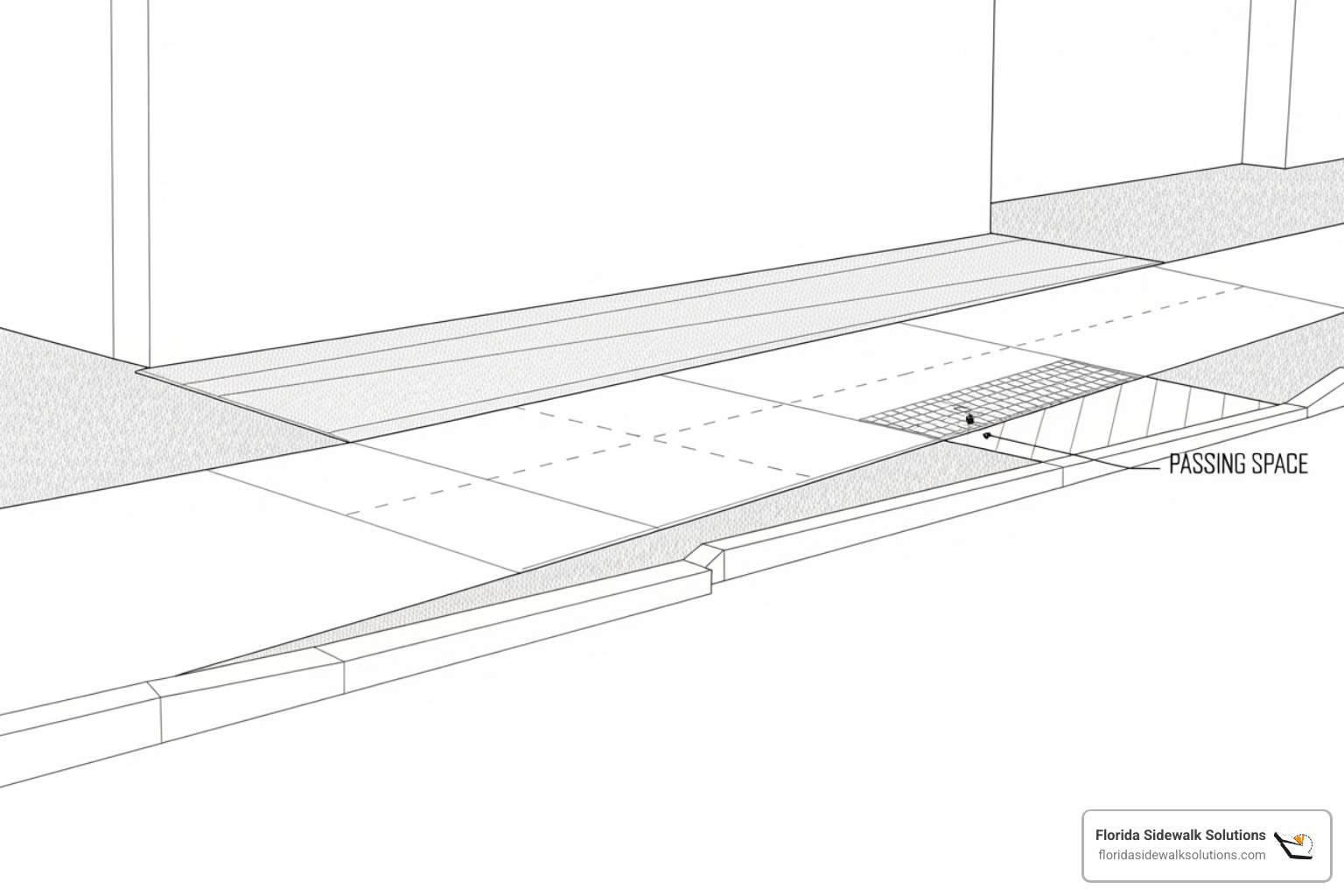
Let’s break down the key requirements. For more details, explore More on ADA Accessibility Guidelines for Sidewalks.
Sidewalk Width, Passing Spaces, and Clear Path
Sidewalk width is critical for accessibility. The minimum width for an ADA compliant sidewalk is 36 inches. To allow two wheelchair users to pass, sidewalks less than 60 inches wide must have passing spaces. These spaces must be at least 60×60 inches and located at 200-foot intervals maximum. While there are narrow width exceptions, they are for very short distances and require maneuvering space.
A clear path of travel must be maintained, free from obstructions like signs, utility poles, or overgrown vegetation. Protruding objects mounted on walls or posts cannot project more than 4 inches into the walkway if their leading edge is above 27 inches from the ground, preventing hazards for people who use canes.
Core Surface and Slope Rules for ADA Compliant Sidewalks
A sidewalk’s surface and slope determine its accessibility.
- Running slope, the grade along the direction of travel, must be less than 1:20 (5%). Anything steeper is classified as a ramp and requires features like handrails.
- Cross slope, the side-to-side slope, must be less than 1:48 (2%). A greater slope can cause wheelchairs to drift and make walking with aids difficult.
- The surface texture must be firm, stable, and slip-resistant, ruling out loose materials like gravel.
- Gaps and openings, such as in grates, cannot be larger than ½ inch in the direction of travel to prevent cane tips and wheelchair wheels from getting caught.
Curb Ramps and Detectable Warnings
Curb ramps are the essential link between sidewalks and streets.
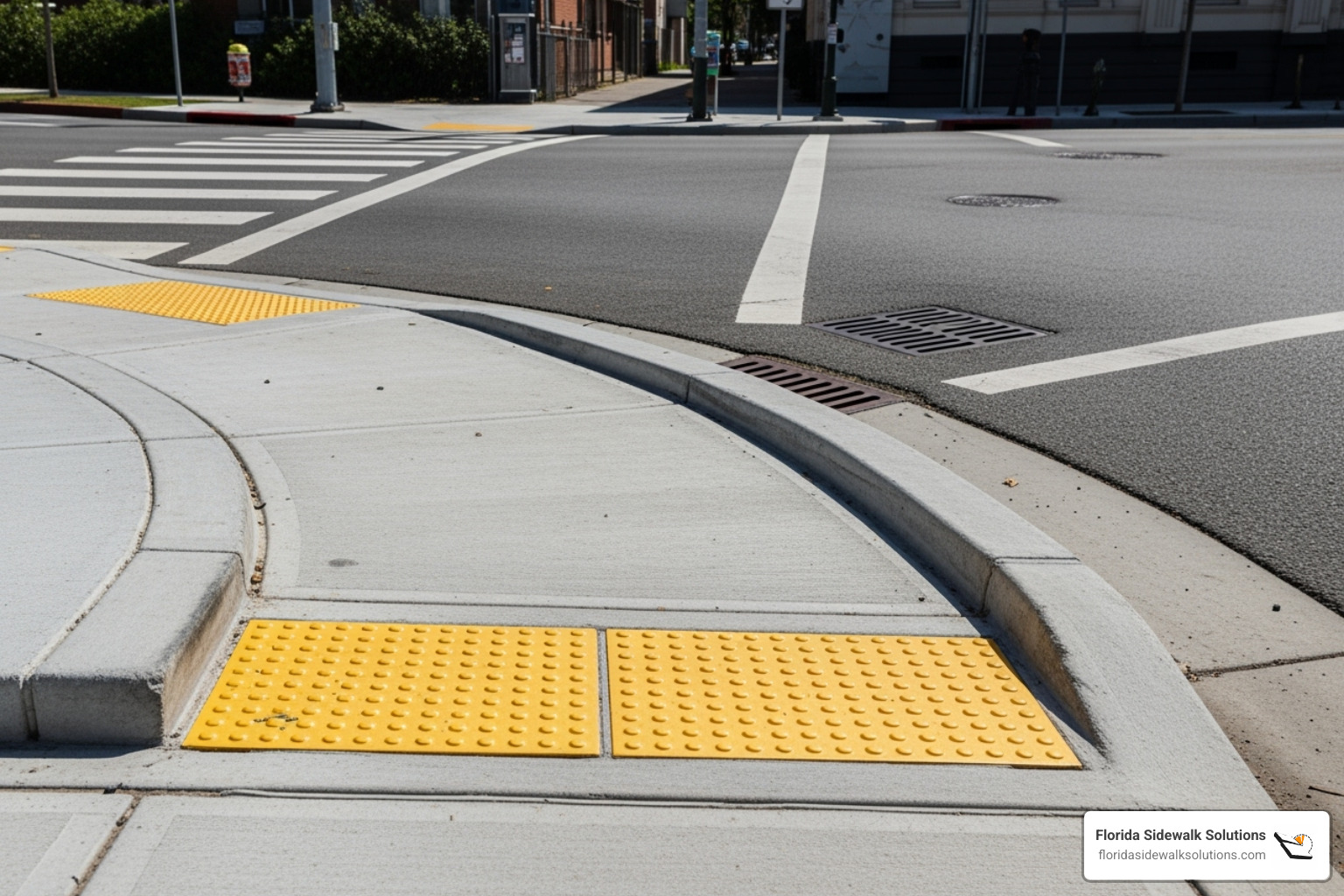
When required, such as in new construction or during alterations, curb ramps must be installed where sidewalks cross curbs. The curb ramp slope must not exceed 1:12 (8.33%), and its width must be at least 36 inches, excluding flared sides. Ramps require landings at the top for maneuvering, which must be at least 48 inches deep with a cross slope of no more than 1:48 (2%).
Detectable warnings are required to alert people with vision impairments of upcoming street crossings. These are typically a grid of truncated domes that must have a visual contrast with the surrounding sidewalk. The warning surface is a 24-inch strip placed at the boundary between the sidewalk and the street. For more, see the Curb ramp guidelines.
Identifying and Eliminating Sidewalk Trip Hazards
An uneven sidewalk slab isn’t just an inconvenience; it’s a safety hazard that can lead to serious injuries and costly lawsuits.
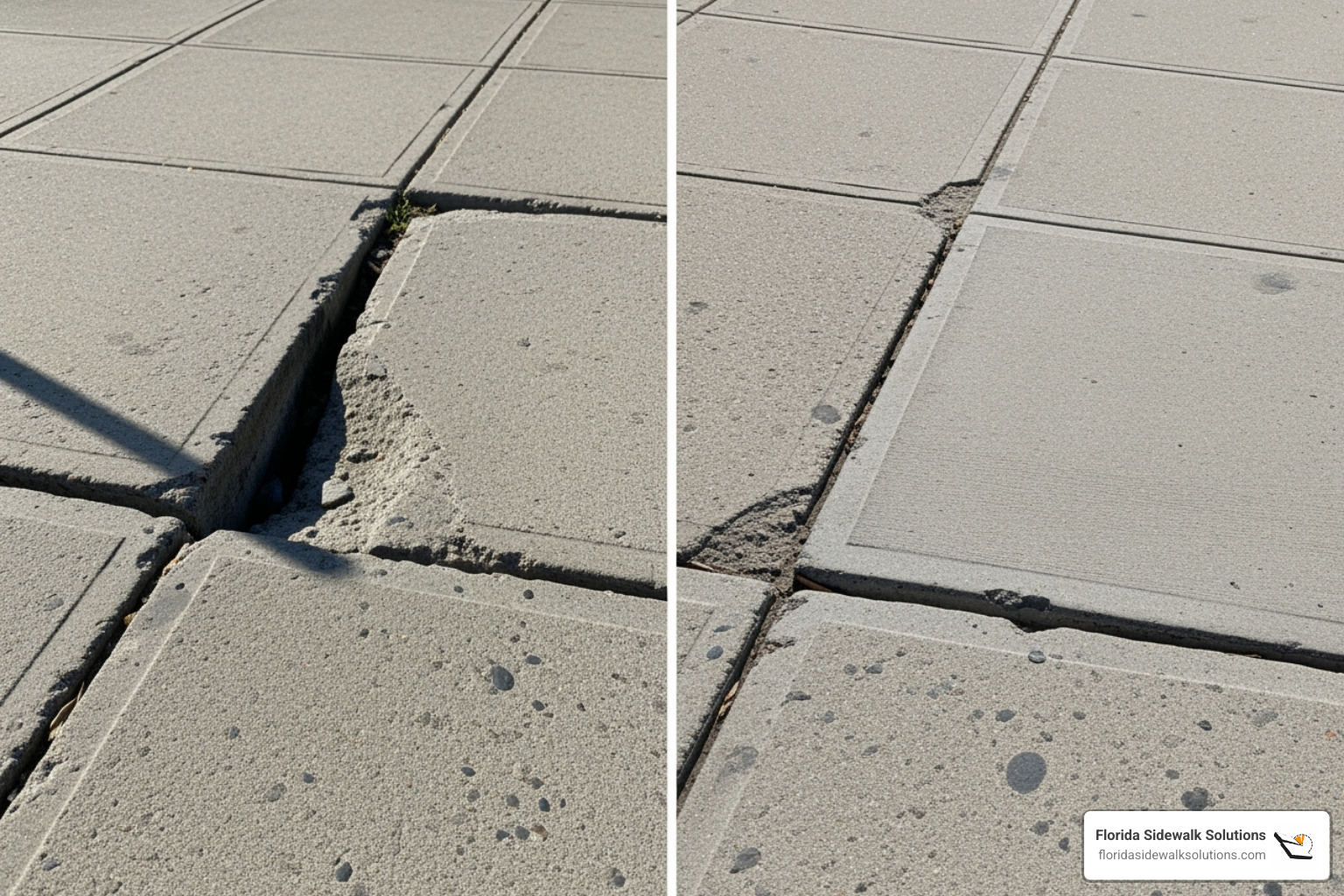
The ADA defines a trip hazard as any vertical change of ¼ inch or more at a joint or crack. This small height is enough to stop a wheelchair or cause a fall. A vertical change up to ½ inch is permissible only if it has a beveled edge with a slope no steeper than 1:2, but complete elimination of the hazard is always the safest option.
These hazards are commonly caused by tree roots, soil settlement, or freeze-thaw cycles. Over time, even well-built sidewalks will deteriorate, making proper hazard removal crucial for maintaining ADA compliant sidewalks. For more on this topic, see More on ADA Trip Hazard Repair.
Trip Hazard Removal Methods for ADA Compliance
Fixing trip hazards can be done in several ways, but the methods vary greatly in effectiveness and cost.
- Grinding: This method shaves down the higher concrete slab but often leaves a rough, discolored surface that may not meet ADA slope requirements and can weaken the concrete.
- Removal and Replacement: This is the most expensive and disruptive option, involving high labor costs, new materials, and significant downtime.
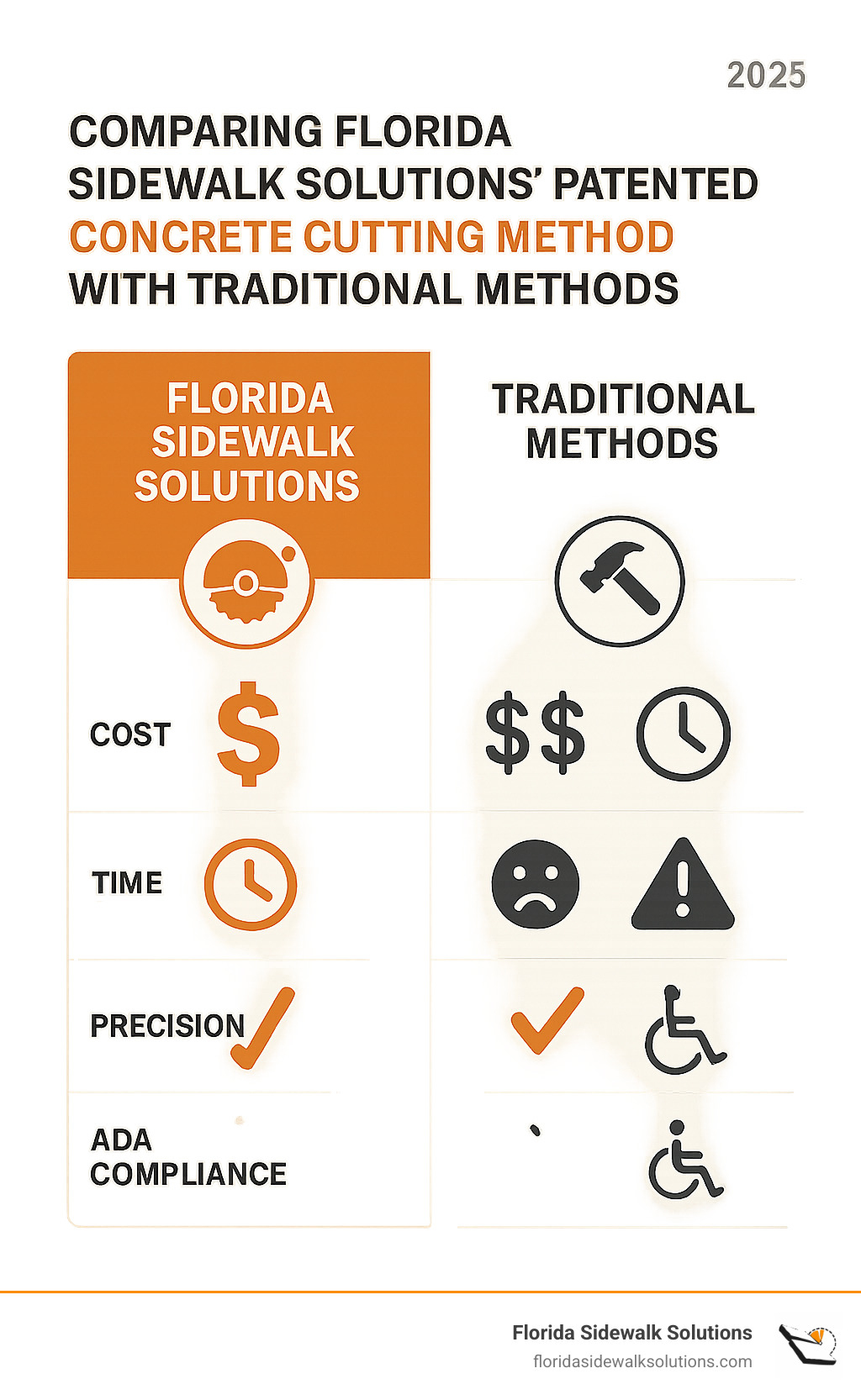
Our patented concrete cutting technology offers a smarter solution. We make clean, precise cuts that taper uneven sections, completely eliminating the trip hazard and bringing the differential to zero. This ensures the exact slope required for ADA compliant sidewalks.
Our method is superior because it:
- Guarantees Compliance: Precision engineering creates a smooth, uniform surface that meets or exceeds ADA specifications.
- Saves Money: It is significantly more cost-effective than replacement, saving municipalities and property managers thousands.
- Is Fast and Efficient: We repair hazards quickly with minimal disruption to pedestrians.
- Eliminates Liability: By completely removing the hazard with surgical precision, you remove the risk of trip-and-fall incidents.
This approach is also environmentally responsible, as it repairs existing concrete instead of creating landfill waste. Learn more about this innovative solution at More on ADA Sidewalk Repair Instead of Replacement.
Consequences of Non-Compliance
Ignoring the requirements for ADA compliant sidewalks can lead to serious legal, financial, and community consequences. A simple ¼-inch trip hazard can escalate into a complex legal problem, affecting your budget, reputation, and community standing. Non-compliance creates a perfect storm of liability that is best avoided through proactive maintenance.
Fines and Penalties
The financial penalties for ADA violations are substantial. According to government-imposed fines guidelines, penalties can be up to $75,000 for a first-time violation and up to $150,000 for subsequent violations. These fines are separate from any damages awarded in a private lawsuit and do not include the cost of legal fees or the mandatory repairs, making proactive compliance a far more economical choice.
Legal Liability and Lawsuits
The ADA is a civil rights law, and individuals who encounter accessibility barriers have the right to take legal action. A trip-and-fall incident can lead to a personal injury lawsuit, resulting in lengthy legal proceedings and significant settlements. The Department of Justice can also launch its own investigations and file lawsuits, which may lead to consent decrees requiring systematic upgrades and ongoing monitoring.
Community Relationships and Public Image
Beyond the financial costs, non-compliance can damage your organization’s reputation. Negative publicity from accessibility failures spreads quickly on social media and in local news. For businesses, this can lead to a loss of patronage, as inaccessible facilities deter not only customers with disabilities but also their friends and family. Most importantly, it erodes community trust by sending a message that the needs of people with disabilities are not a priority.
Conversely, investing in ADA compliant sidewalks demonstrates a commitment to inclusivity and safety, strengthening community relationships. The cost of compliance is always less than the cost of non-compliance. For more details, visit More on ADA Compliance Violations.
Frequently Asked Questions about ADA Sidewalks
ADA compliance can be complex, balancing safety, legal requirements, and budgets. Here are answers to some of the most common questions we receive.
Do residential sidewalks have to be ADA compliant?
The answer depends on ownership and location. Most sidewalks, even those in front of private homes, are located in the public right-of-way and are considered public infrastructure. As such, they must be ADA compliant. In new developments, the developer is responsible for installing accessible routes. For existing sidewalks, there is no mandate for cities to upgrade every sidewalk at once. However, when any alteration or repair occurs, the sidewalk must be brought up to current ADA standards.
Local rules can vary, and some jurisdictions may hold adjacent property owners responsible for maintenance. Truly private sidewalks within a single-family home’s property lines are exempt, but walkways in housing complexes that lead to common areas may still need to be accessible.
What is the difference between a sidewalk slope and a ramp slope?
This distinction is crucial, as it determines the required design features. A sidewalk’s running slope (the grade in the direction of travel) must be less than 1:20 (5%). If the slope is 1:20 or steeper, it is classified as a ramp.
Ramps can have a steeper slope—up to 1:12 (8.33%)—but they have much stricter requirements, including level landings, handrails on longer runs, and edge protection. Keeping walkways in the “sidewalk” category by maintaining a gentle slope avoids the significant costs associated with ramp construction.
How is a trip hazard officially measured for ADA compliance?
Precision is key when measuring trip hazards. The official ADA definition is any vertical change of 1/4 inch or more at any joint or crack. This is enough to impede a wheelchair or cause a fall. A vertical change of up to 1/2 inch is allowed only if it is beveled with a 1:2 slope (one inch of height for every two inches of run).
However, the safest approach is to eliminate vertical changes completely. Our technicians use precision tools to measure these differentials. Our patented cutting technology is designed to solve this problem by bringing the settlement back to zero, creating a smooth transition that exceeds ADA requirements and ensures genuinely safe ADA compliant sidewalks.
Conclusion: Building a More Accessible Community
Creating ADA compliant sidewalks is about building a community where everyone can move freely and safely. By maintaining proper sidewalk width, correct slopes, and eliminating trip hazards, we create pathways that serve all residents.
Non-compliance carries severe consequences, including fines up to $150,000, lawsuits, and community distrust. Proactive maintenance is the key to avoiding these issues. Instead of waiting for a complaint, smart managers address sidewalk hazards before they become liabilities.
Florida Sidewalk Solutions offers a superior alternative to traditional repair methods. Our patented cutting technology is a precise, cost-effective, and efficient solution designed to meet all federal standards for ADA compliant sidewalks. We eliminate trip hazards completely by bringing uneven surfaces to a zero point of differential settlement, creating a smooth, safe transition.
Our method costs significantly less than sidewalk replacement, allowing municipalities with tight budgets to repair more sidewalks and improve community safety. Investing in proper sidewalk maintenance is an investment in your community’s future.
Ensure your property is safe and compliant. Learn more about our concrete sidewalk surface repair services and how our innovative approach can create truly accessible pathways for your community.

